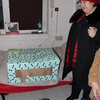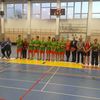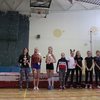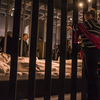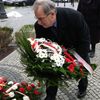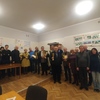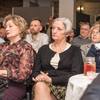Line A – southern part of the city
1. The plaque commemorating acts and heroic death of cavalry captain Witold Pilecki (1901-1948), located at Bohaterów Polski Podziemnej Square (Piłsudskiego str. and Warszawska str. corner)
In 1940, Captain Witold Pilecki, a soldier in the Home Army, deliberately allowed himself to be arrested under a false name and sent to Auschwitz where he organized a camp opposition group. Using a radio transmitter built in the camp, he sent the first accounts about the camp to London. After escaping from there in 1943, he continued his subversive activities. He fought in the Warsaw Uprising and after a spell in a Prisoner-of-War camp he made his way to Polish II Corps in Italy. After returning to Poland, he organised underground anti-communist activities. Arrested in 1947, he was sentenced to death on charges of espionage. He was executed in 1948.

2. Kalkstein’s house, at 21 Warszawska str. and Grudowska str. corner
In this house lived Aleksandra Rogowska, a Scout Leader. In her flat in October 1939 a group of pre-war girl scouts took an oath of secrecy; this marked the beginning of subversive activity by girl scouts in the Milanówek area. The house was built in 1913 and extended in 1926.

3. Villa „Alfa”, at 11 Fiderkiewicza str. (earlier Żwirowa str.)
In September 1939, after the first bombardments in the area, a small hospital was organized in this villa by Dr. Alfred Fiderkiewicz, a highly regarded Milanówek physician and social activist who had been an activist in the KPP (Polish Communist Party) in pre-war years. His house was subsequently a contact point for Communist activists from the “Proletarian” group. Marceli Nowotko, the leader of the Polish Workers’ Party was also stayed here at one time. The villa was built in 1931.
4. Villa „Marysia”, at 12 Fiderkiewicza str.
An underground training school for non-commissioned officers of the Home Army was organized in Brunon Wasilewski's flat in this villa. One of the instructors was Lieutenant Mścisław Thommée (1917-1986). He was awarded the Cross of Merit for Bravery as well as the Home Army Cross and the Partisan Cross (the last two posthumously). The villa was built in 1913.
5. Villa „Stefania”, at 16 Fiderkiewicza str. (During the war: 6 Grudowska str.)
In 2002 a plaque was placed at its entrance to commemorate described events.
After the Warsaw Uprising – place where meetings of civilian authorities of the Polish Underground State took place. The National Council of Ministers under the leadership of vice-prime minister Stanisław Jankowski also held here their sessions. Here the National Unity Council had their sittings with participation of the following politicians: Kazimierz Pużak, Kazimierz Bagiński, Antoni Pajdak, Adam Bień, Stefan Korboński, AK chief commander general Leopold Okulicki - "Niedźwiadek" (used to stay for night in this house), Jan Nowak-Jeziorański a Polish government-in-exile courier in London would also visit the villa.
Part of the ground floor and the verandah belonged to „U Aktorek” cafeteria run by actresses and singers, among others: Ewa Bonacka, Ewa Kunina, Barbara Kostrzewska, Anna Borey and Krystyna Minkiewicz, sister of Władysław Minkiewicz, prewar diplomat, owner of the villa. Minkiewicz was a deputy to the General Division of the Government Delegate’s Office, secretary for safety and contacts with the National Unity Council and the secretary to Roman Knoll, foreign affairs department director, who lived in Milanówek in the villa „Pod Matką Boską”. The villa was a contact point mainly for artists who, having left Warsaw, arrived to Milanówek.
Artistic shows were the camouflage for political meetings. At that time Milanówek started to be called „Little London”. Adam Bień – first deputy for the Government Delegate and since May 1944 first vice-prime minister – wrote in his memoirs : "Crowded streets (...) Milanówek is the capital city of Poland". About 50-60 thousand people came to or passed through Milanówek, which at that time became a centre of civil underground movement.
The villa was built in 1911.
Plaque:
In this house, after the Warsaw Uprising, meetings of civilian authorities of the Polish Underground State were held with the participation of AK Commander-in-Chief, general Leopold Okulicki “Niedźwiadek”. The cafeteria „U AKTOREK” was a contact point for underground activists.
To commemorate 60th anniversary of the time, when our town played the role of the capital city of Poland and 65th anniversary of establishing Polish Underground State,
Unit „Mielizna” ŚZŻAK
Mayor, Town Council,
Milanówek Community
27.09.2004.

6. Rev. P. Skarga Public School No 1, at 69 Królewska str.
During the German occupation, a secret education centre was organized here by Ludwik Starościak. Almost all pre-war teachers participated. After the Warsaw Uprising, a branch of Dzieciątka Jezus Hospital was housed here. The headquarters of the hospital were located in the villa Bożenka at Spacerowa 3 with a second branch in the villa Kresy.
7. Villa "Zorza", at 2 Leśna str.
After the collapse of the Warsaw Uprising, the Commander in chief of the Home Army, General Leopold Okulicki (Niedzwiadek) stayed here for some time. Many politicians who found themselves at that time in “Little London” participated in underground meetings held in this building. The building was erected in 1930.
8. Villa „Perełka”, at 12 Grudowska str.
In 1939, a first aid post was set up in this villa: it was used by wounded Polish soldiers while marching through Milanówek. In July 1944, a hospital was set up here for about 100 casualties brought from Warsaw and Dulag 121, the Pruszków transit camp. The majority of the auxiliaries were boys and girls – Home Army soldiers and scouts from Mielizna. The villa was built in 1911.

9. Villa „Marysia”, at 13 Prosta str.
After the Warsaw Uprising, a maternity hospital managed by Doctor Edward Fitkau was housed in this building. It was a branch of the gynecological and maternity clinic on Starynkiewicza Street in Warsaw. 20 maternity cases as well as 20 mothers and babies found help here. The staff team which cared for the patients numbered about 15.
10. Villa „Nasza”, at 18 Prosta str.
After the Warsaw Uprising many important meetings of the Government Delegate’s Office, National Unity Council, National Council of Ministers and political parties took place in the villa. The Strumiłło family made their apartment available for secret meetings. Leaders of the Polish Underground State held here regular meetings since October 1944. It was in Milanówek that leadership of the Polish Underground State finally decided to discover themselves to Soviet authorities. After that decision they went to NKWD Office in Pruszków in response to the invitation for talks with the Soviet party under the guarantee of full inviolability. On 27th March 1945, after the first day of talks with general Iwan Sierow (acting under the codename "general Iwanow"), part of the Polish delegation, including Jankowski and Okulicki, were arrested and sent by plane to Moscow. The next day the remaining ones followed them. Between 18th and 21st June 1945 a dramatic trial called „Trial of the Sixteen” took place. It was staged in details by Stalin. The purpose of the trial was to disgrace leaders of the Polish Underground State in front of the USA and Great Britain - opponents of imposing Soviet domination in Poland. All the tried were sentenced to many years imprisonment. Some of them were soon released. Some others, including Bień, survived and having served „part” of the sentence came back to Poland. Others – like Stanisław Jasiukiewicz – died in unknown circumstances, general Leopold Okulicki – on 24th December 1946 and Jan Stanisław Jankowski - on 13th March 1953.
The villa was built in 1911.

11. Villa "Ostoja", at 4 Dębowa str.
During the occupation, Jews were hidden in this house and many others throughout Milanówek. During the era of “Little London”, the well-known Piłsudczyk Henryk Józewski stayed in Milanówek. There was also a local contact for Colonel Jan Rzepecki, leader of the organization, Nie and the Armed Forces Delegation and the President of the Central Executive Committee of the Association "Freedom and Independence". In the years 1944 – 1945 there were many underground meetings ; participants included General Leopold Okulicki (Niedźwiadek), Commander-in-chief of the Home Army and Kazimierz Moczarski, author of Rozmowy z katem.
12. Villa, at 5 Dębowa str.
At 16.00 on 1st November 1941, in the one-roomed ground floor flat of Lech Michalski (codename Skierski), was held a swearing-in ceremony of newly recruited soldiers to a 7-person section of Narodowa Organizacja Wojskowa - NOW (National Military Organization). This historical section included: Czesław Reut-Żeromski, Ryszard Witkowski codename „Romuald”, Stanisław Markowski codename „Lubicz”, Jan Radkowski codename „Kula”, Andrzej Sielużycki, Zbigniew Oraczewski codename „Kogut”, Leonard Borowiak codename „Niktowicz”. All of them were standing in a line. Mieczysław Teodorczyk codename „Blacharz” would read the Oath and each new soldier, one by one, would repeat it. Then „Blacharz” would shake each soldier’s hand and kissed them on the cheek. In the spring of 1943, NOW merged with the Home Army in Milanówek.
13. Central Experimental Silk Station (CDSJ/CESS), at 1 Brzozowa str.
Thanks to the commitment of its owners, the siblings Stanisława and Henryk Witaczek, the Silk Station played an important role during the war. It provided employment to young people, so protecting them from deportation for forced labour. More than half the workforce became members of the Home Army. Some sections were completely staffed by them - for example, the Engineering Department where weapons were repaired and parts made and the Finishing and Dyeing Department in which the engineer Miron Krasnodębski started large-scale production of mercury fulminate which was used to manufacture a type of hand grenades called "sidolówka". The first building of the Silk Station came into use in 1930. Extension work continued until 1945.
14. Villa „Sławka” (commonly known after its owner as “Piekarski’s House”), at 33 Piłsudskiego str.
The house belonged to the Piekarski family who were involved in the subversive work of the Home Army and the Szare Szeregi (subversive scouting movement). After the Warsaw Uprising, corridors of the villa were used as temporary shelter for refugees from Warsaw and for those who had managed to escape from Dulag 121, the transit camp in Pruszków. The Oaza cinema which was in an adjoining building was turned into a temporary hospital. The villa was built in 1928 and the cinema in 1932.
.jpg)
15. Waiting rooms of EKD terminal and PKP station, at 36 Warszawska str. (nowadays “Klubokawiarnia Fonostacja”)
Doctor Franciszek Bohdanowicz organized a first aid point at the station to receive casualties from Warsaw and Pruszków; he was supported by nurses from the Polish Red Cross (PCK). Food for patients and staff was supplied by the Central Welfare Council (RGO), Polish Red Cross, the Home Army’s quartermaster and inhabitants of Milanówek.

Below, extra villas that you can find on this route:
a. Villa „Aleksandrówka”, at 16 Warszawska str. and 2 Prosta str. corner, (doesn’t exist any more)
Distribution Centre for underground press and publications.
After the Uprising a few tens of fugitives from Warsaw found their shelter in the Villa. Polish Government Delegate at Home Jan Stanisław Jankowski stayed for a couple of nights here. Felicja Witkowska, owner of the photographic studio, who lived here together with her children Aniela and Ryszard in 1993, received a medal “The Righteous Among the Nations” for helping Jews. In her apartment AK „Foto” Unit was located. Wacław Żdżarski, a journalist and photographer, chief instructor of the 6th KG AK Division, in cooperation with Felicja and Ryszard Witkowski were in charge of it.
The villa was built in 1911.
b. Villa „Gloria”, at 14 Warszawska str. (in the state of rebuilding)
On 1st October 1944, after evacuation from Warsaw, the Warsaw PCK hospital „przy Skarpie” was located in the villa with its surgical and internal diseases wards, medical staff and about 100 injured. Doctors, nurses and helping staff were working in extremely hard conditions days and nights, getting hardly any food and no money for their work. In return for their devotion and tremendous effort, local people rushed to help and provided them with food supplies.
All 10 hospitals transferred from Warsaw to Milanówek ensured medical care to the total of about 1500-2000 sick and injured.
On the front a plaque commemorating location of the PCK (Polish Red Cross) hospital transferred from Warsaw after the Uprising.
The villa was built in 1929.
c. Villa „Emiliówka”, at 3 Warszawska str.
Here was the distribution centre for underground press and editorial office of a daily newspaper „Tu mówi Londyn!” (“Here’s London speaking!”) (subtitled:„Wieczorne Pismo Codzienne” – Evening Daily) issued by Janusz Bień and Leonard Borowiak (AK) from August 1944 to January 1945. The newspaper included news on battles and fights on all fronts of the Second World War (received mainly from the BBC radio watch) complemented with local news. It was distributed in Milanówek and other towns situated along EKD railway line from Grodzisk Mazowiecki to Włochy.
There was also a secret „contact point” in the villa for „Zagrody” (ZWZ-AK) communication with abroad, managed by a courier Elżbieta Warzycką-Kowza codename „Elżunia”. Here the documents were collected and delivered to other places. After AK had been disbanded, „Elżunia” joined organization called Wolność i Niepodległość (Freedom and Independence) -WiN. Having been arrested in 1947 she was sentenced to 7-year imprisonment, which she duly served.
The villa was built in 1905.

d. Villa „Miecin”, at 22 Piłsudskiego str.
In 1944 r. at Wacław Drzewicz’s restaurant which used to be situated on the ground floor general Leopold Okulicki appointed to a position of AK Commander-in-chief held his first meeting with the authorities of the Polish Underground State staying at that time in Milanówek. In November and December general Okulicki (who was quartered in Częstochowa) often visited Milanówek and stayed at the villa „Stefania” in the Małcużyńskis’ apartment.

e. Villa „Księżanka”, at 52 Warszawska str.
After the Uprising a nursery was arranged in the villa housed about 120 children and around 40-person staff looking after them.
The villa was built in 1912.

f. Villa „Kaprys”, at 31 Piłsudskiego str.
During the war the villa was a shelter refugees. At times it sheltered up to 200 people.
The villa was built in 1900.
g. The Hellers’ House, at 21 Inżynierska str. (in the breakdown)
Headquarters of the 32 AK platoon commander Stefan Heller, codename „Sokólicz”. From 1942 he was also the head of the VI Division of the Information and Propaganda Bureau (BIP) for the Western Sub-Area. The villa also housed radio watch, meetings of the „Mielizna” and „Bażant” district headquarters as well as several sessions of the National Unity Council and National Council of Ministers. Heller was the last commander of the AK „Mielizna” Unit until 19th January 1945, when he disbanded AK units after the Soviet army had entered Milanówek.
h. Villa „Sówka”, at 4 Piotra Skargi str. (doesn’t exist any more)
The Villa doesn’t exist any more but it is worth mentioning because of the role it played during the war. It used to be place of the secret meetings for AK members. Here several dozen of refugees, including Jews, found their shelter. Therefore in 2007 the Yad-Vashem Institute awarded, post-mortem, to its owner Hjalmar Uggla (1908-83) and his wife Ludwika the „Righteous Among the Nations” Medal. Uggla, as a person of Swedish origin, was permitted to have a radio, which was used by local AK for radio watch. (Uggla himself belonged to the 32 AK platoon since 1940). Thanks to his fluency in the German language and job in the Central Experimental Silk Station, he saved about 200 Milanówek residents from Gestapo.
The villa was built in 1905.
*
Today, after so many years have passed, it is hard to believe that in the autumn 1944 it was possible to create in Milanówek conditions for temporary accommodation for thousands of Warsaw refugees and to house many hospitals and a huge orphanage of Rev. Baudouin evacuated from Warsaw, at the time the Warsaw Uprising was dying down, the war still wasn’t over, there was no basic medical stuff or food and the conditions were less than poor. The credit for that didn’t just go to devoted doctors and nurses who came to Milanówek with their patients, but also to Milanówek residents and the good will of hundreds of farmers and landowners from nearby villages who voluntarily came for help providing food, dressing and medicines. The contribution of AK soldiers from „Mielizna” Unit as well as scouts from Szare Szeregi and girl-scouts from underground teams to successful organization of life in our city was crucial.
Working conditions of doctors, nurses and helping staff were extremely hard. They were working non-stop, days and nights, for hardly any food and no money. It was a great, spontaneous fight for people’s lives, for the sick and the injured. We should be aware of this when visiting commemorative places of “Little London” so that superhuman effort, devotion and work of doctors, nurses and local people remain in the memory of future generations.
The contents of the walk around the memorial places related to the traces of the Second World War in Milanówek were
developed by Andrzej Pettyn
Footnotes
7. A. Bień, "Bóg wyżej - dom dalej 1939-1949", Warszawa 1991
8. "Proces szesnastu. Dokumenty NKWD", Oficyna Wydawnicza RYTM, W-wa 1995, s.7.
Bibliography of publications on the world war II in Milanówek:
- Andrzej Stawarz, dr (red.); A. Góralski, A. Kołodziejczyk, A. Stawarz, R. Turkowski „Zarys dziejów Milanówka”, wyd. Urząd Miasta Milanówek 1995
- Tadeusz Sowiński „Jedwabna konspiracja”, Burchard edition, W-wa 1998
- Andrzej Pettyn „Kiedy Milanówek był stolicą…”, Milanówek SIT 2000
- Andrzej Pettyn „Milanówek - Mały Londyn”, TMM 2004
- Andrzej Pettyn „Milanówek - miejsce magiczne”, TMM 2005
- Zofia Żuławska „Parafia św. Jadwigi w Milanówku”, TMM 1998
 Wersja do druku
Wersja do druku
